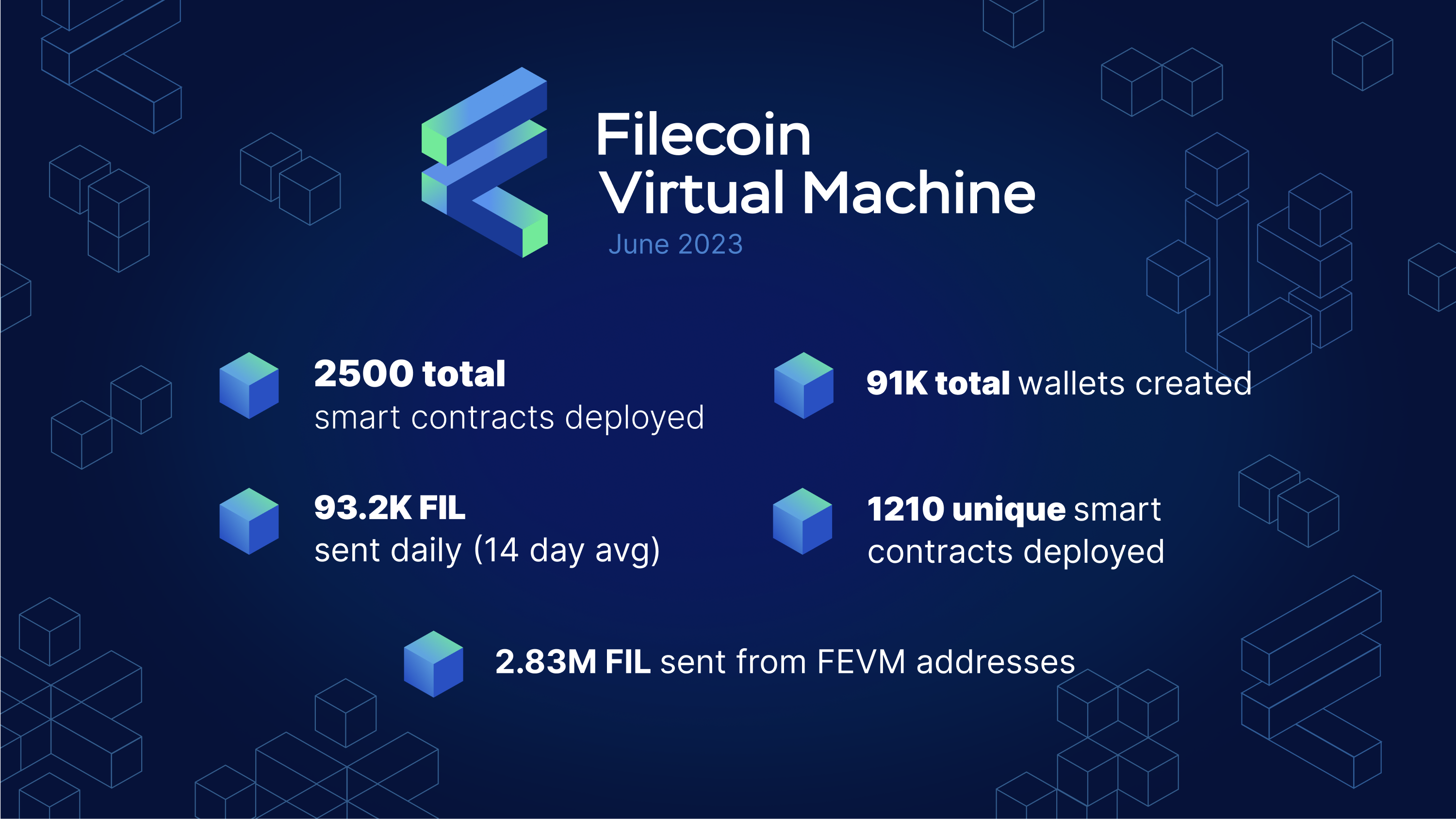100 Days of FVM
100 days ago, on March 14, 2023, the Filecoin network introduced the first programmable runtime on the Filecoin Virtual Machine and became programmable (re-read the announcement blog post). The launch solidified Filecoin as the L1 uniquely positioned to power the open data economy. Since then, the open ecosystem of developers, storage providers, storage clients and other network participants of Filecoin, the largest open access cloud service, has grown further. Join us as we take a closer look at the notable progress achieved by the FVM since its launch on Filecoin’s mainnet.

The Filecoin Virtual Machine: Supercharging the Filecoin economy
When FVM launched, the community was energized by the prospects of moving much of the Filecoin economy’s activity on-chain. We were hoping that the FVM would accelerate our path to achieving key goals of the Filecoin Master Plan. A few of those priorities included:
The on-boarding and management of datasets onto what is the largest decentralized cloud storage network in the world with more than 12M TB of capacity offered at cost-competitive rates. Today, 100 days after launching the FVM, smart contracts are able to facilitate and aggregate storage deals fully autonomously, thus helping storage clients find the best storage provider for their specific needs automatically.
Additionally, FVM allowed the Filecoin community to build discovery and reputation services on the Filecoin blockchain and increase transparency of the network. Many of the Filecoin block explorers have begun augmenting their dashboards with data pulled directly from the Filecoin blockchain and helping guide decisions and bring greater trust and transparency to the Filecoin network (e.g., by verifying smart contracts).
The FVM also promised to facilitate the leasing and borrowing of FIL, Filecoin’s native token which is used by Storage Providers to commit to, grow, and secure the Network. To start, many prominent cryptocurrency exchanges quickly implemented support for FVM wallet address compatibility (f4) so that Filecoin network participants could interact not only with the new FVM dApps, but also familiar tools like Metamask. Specifically, to-date, over 82,000 unique wallets have interacted with FVM since launch. Furthermore, measured by growth in Total Value Locked (TVL), decentralized financial services on the Filecoin network are the fastest growing (+140% MoM) in the Top 100 of all blockchains now reaching almost 4.5M FIL across several providers.
At launch, community members hoped that the FVM would augment the functionality of products and services emerging in other web3 communities using Filecoin and the FVM’s capabilities (e.g., data storage). Roughly three months after launching the FVM, multiple integrations with bridges such as Axelar and Celer and over 35 other key partners have brought Filecoin closer to the rest of web3, enabling a rich set of message and transaction exchanges between the Filecoin and other web3 ecosystems.
Many unique smart contracts and dApps (more than 1,200 combined) have been launched on FVM, however the user base of many of these apps is still relatively nascent. Over the next weeks and months, the Filecoin community aims to continue accelerating the success of FVM.
dApps that unlock utility for end-users
These new possibilities unlocked by the FVM have led to a flurry of developer and entrepreneurial activity – both of existing and new communities. At the time of writing, there are over 1,100 unique smart contracts powering dApps that have been deployed to the Filecoin network. There are over 80,000 wallets that have been created and begun interacting with these FVM-powered dApps. And we have surpassed 2.8M FIL in total balance across FVM accounts and contracts.
The FVM’s full compatibility with the EVM that runs on top of the Ethereum blockchain, helps many new-to-Filecoin developers make rapid progress when deploying their solutions on the Filecoin blockchain, as a result, the community interest in hackathons continues to soar. Specifically, we have hosted two FVM-focused hackathons, Space Warp (pre FVM-launch) and HackFS, which have attracted over 1700 developers combined. In addition, all open project slots for two dedicated FVM-accelerator programs have been fully committed with teams building products and services at the frontier of this new technology.
There are also numerous notable decentralized applications that have launched on FVM and span across multiple categories. Although the Filecoin Ecosystem Directory is currently being revamped, it will soon be the best place for community members to add to or browse the ever-growing list of products and services running on Filecoin. But for now, here are just a few of the incredible web3 projects who are building on or have integrated FVM.
Infrastructure Tools
Storage & Cloud Services
Education, Science & Public Goods
- Lagrange DAO
- Shale Protocol
Media & Entertainment
Filecoin Pledging
- Glif
- Collectif DAO
- stFIL
- SFT Protocol
- Filet Finance
- HashMix
- NodeDAO
- FilFi
The road ahead: Filecoin to shape the open data economy
In the past quarter, we focused on securing key partnerships and removing roadblocks. As we launch into the second half of 2023, we expect to prioritize experience for both users of FVM dApps as well as developers working with FVM.
We plan on building with a focus on smaller storage deals, in order to democratize storage on Filecoin and FVM. This will allow building dapps and DAOs around pieces of individual, user-uploaded data. They can create unique incentive flows in order to replicate, renew and repair storage deals on top of this democratized standard. We are working with aggregators on Filecoin and making them FVM native – so that builders can upload small pieces of data via their dapps and smart contracts.
We are also building a decentralized aggregation standard that will allow anybody to spin up “data dropboxes” for FVM. We want this to enable truly trustless aggregation on Filecoin, all managed on-chain through FVM. Dapps and DAOs can be built on this standard so that new data can be uploaded, and storage deals can be renewed, replicated and repaired all through a decentralized aggregation standard.
What kinds of things do we expect to unlock down the road? A bunch of awesome platforms on top of FVM: decentralized compute, data marketplaces, and DAOs built with LLMs and generative AI. We expect teams to build a marketplace for arbitrary compute jobs, especially for model training and inference on top of data stored on Filecoin. We predict robust marketplaces for IPNI dispute resolution, data preparers, and REC tokenization. We expect LLMs to play a central role in open source generative AI models, all built as dataDAOs on top of FVM. With data, AI and compute, the future is bright for FVM!
Finally we are doubling down to make sure FVM is easy to use. We want it to be painless to upload funds, data and smart contracts onto FVM. We are working with our close partners – wallets, exchanges and explorers – to make sure these onramps make sense for builders. If you want to build in this space, let us know!
Check out the most recent Filecoin and IPFS Ecosystem Roundup for a comprehensive view on the developments in this ecosystem and more insights and commentary.
Stay up to date with FVM
As mentioned above, it is never too late to get involved in building with FVM! If you’re looking to get involved in upcoming hackathons, check out the Filecoin Ecosystem Hackathons home page. Or, if your project is accelerator-ready, check out Softnoise, by Protocol Labs to find the one perfect for you. Lastly, still itching for more FVM resources? Take a look at the FVM linktree.




